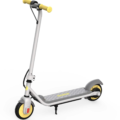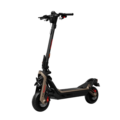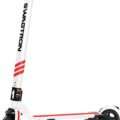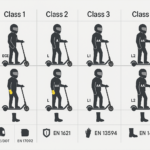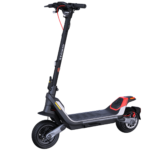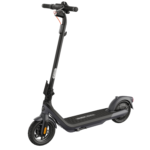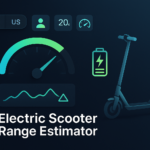- Home
- Scooters
- Electric Scooters
- Segway Ninebot GT3
Segway Ninebot GT3
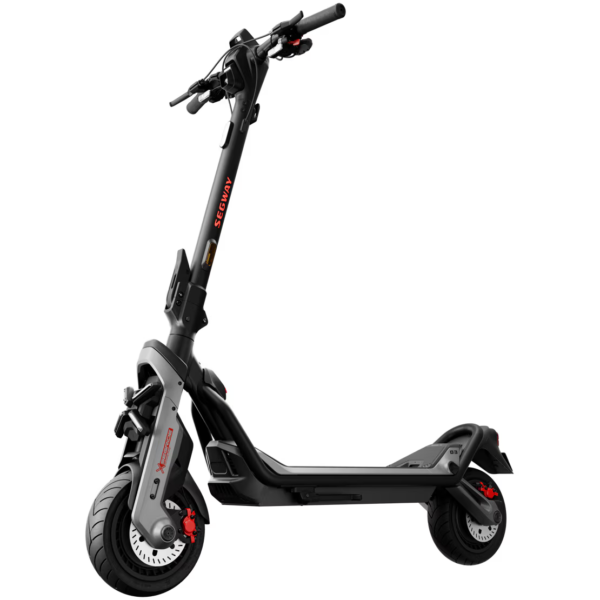


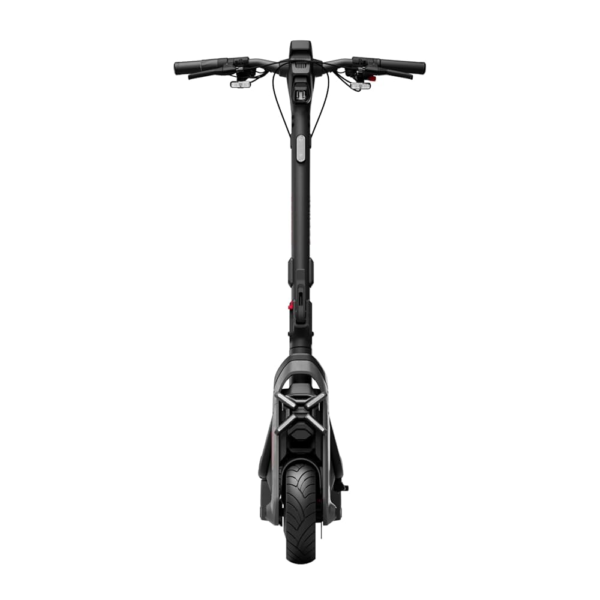
- Battery Range: 95 km
- Top Speed: 25 km/h (EU GT3 E) / 31 mph (US)
- Motor Power: 700 W nominal (EU) / 2400 W max; ~1000 W nominal (US retailer)
- Weight Capacity: 150 kg
- Charging Time: ≈5.5 h (flash charge)
- Scooter Weight & Portability: ≈39.5 kg
PROS
- IPX6 body and IPX7 battery protection
- Dual hydraulic suspension with 11" self-sealing tubeless tyres
- Dual disc brakes plus integrated indicators and TFT display
CONS
- EU top speed limited to 25 km/h
- Heavier chassis than commuter-class models

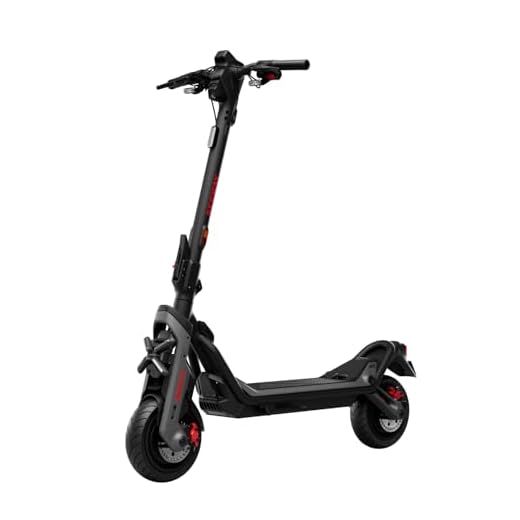
Overview
Segway Ninebot GT3 Specifications — Purpose of This Page
This is a specifications page for the Segway Ninebot GT3. It organizes the technical details buyers reference most: battery capacity and charging, motor output and speed caps, suspension layout and damping, braking hardware, tyres, water protection, dimensions and mass, cockpit and connectivity, and regional differences. It avoids opinions and focuses on measurable attributes so you can align numbers with daily routes and local regulations.
The GT3 is a SuperScooter-class single-motor platform that emphasizes range, weather protection, and consistent braking. EU documents list an 899 Wh battery with Smart BMS 2.0, IPX6 body sealing, and an IPX7 battery rating. The frame integrates front hydraulic double shocks and a rear hydraulic trailing arm. Dual disc brakes, 11-inch self-sealing tubeless tyres, and a color TFT dashboard round out the package. Because markets vary, the EU GT3 E caps speed at 25 km/h, while non-EU listings often quote higher limits.
Battery Capacity, BMS, and Real-World Range
Battery capacity is listed at 899 Wh (46.8 V class). Under controlled tests at 15 km/h, the EU GT3 E claims up to 95 km. At 25 km/h, the same material cites up to 75 km. Actual range depends on temperature, rider mass, elevation, and average pace. For planning, expect less at sustained higher speeds or in cold weather. Smart BMS 2.0 manages cell protection, thermal limits, and pack balancing. Additionally, EU materials describe a flash-charge system targeting roughly 5.5 hours to full. A one-hour top-up is quoted to add about 20 km at 25 km/h under specified conditions.
Segway also notes an optional 468 Wh add-on battery designed to extend range. Availability is indicated for later cycles, and regional release windows can differ. When installed, the combined capacity raises the stated figures to approximately 125 km at 15 km/h or 100 km at 25 km/h. Because accessories evolve, confirm your market’s package contents and dates before purchase.
Motor Output, Speed Caps, and Gradient
The GT3 uses a rear hub motor. EU sheets list 700 W nominal output with a maximum power of 2400 W, and a rated climbing ability up to 30% on suitable surfaces. In the EU, top speed is limited to 25 km/h. In other regions, retailer listings often show higher nominal values (commonly around 1000 W) and up to 50 km/h top speed, alongside a ~45-mile max range claim. Because these numbers are region dependent, always confirm the suffix printed on your unit and the applicable local limits before configuring modes.
Ride modes usually include Eco, Standard, and Sport. Eco prioritizes range by moderating acceleration and capping speed. Standard covers most daily use. Sport sharpens response for short merges and hills. Since these are software envelopes, switching modes changes behavior without altering hardware. For long descents, electronic regen helps stabilize speed while harvesting small amounts of energy.
Suspension Layout and Adjustability
The GT3’s suspension pairs front hydraulic double shocks with a rear hydraulic trailing arm. This arrangement separates steering inputs from bump absorption and improves tyre contact on patterned concrete and patched asphalt. Damping adjustability allows tuning for rider mass and surface texture. Heavier riders typically add damping to control rebound. Lighter riders may reduce damping for comfort on low-speed chatter. Because geometry remains consistent through travel, steering feels settled at 25 km/h and on faster, legal roads in non-EU markets.
As a quick baseline, start at factory settings. Increase damping if the front rises quickly after sharp hits. Reduce damping if small, frequent ripples feel harsh. Recheck tyre pressure after changes; pressure and damping interact strongly and influence steering precision.
Braking System and Heat Management
Dual disc brakes at the front and rear provide heat capacity for repeated stops. Rotor sizing and caliper hardware are designed for predictable lever feel when pads are bedded correctly. While EU literature emphasizes dual discs, many markets also mention electronic features that coordinate deceleration with regen strength. Because braking is ultimately limited by contact patch and surface grip, tyre condition and pressure remain critical. For service, inspect pad thickness, confirm rotor alignment, and replace consumables at recommended intervals.
New pad bedding is straightforward. Perform a series of progressively harder stops from moderate speed to bring pads and rotors to operating temperature. Avoid long holds with hot pads against a stationary rotor. This helps maintain consistent friction and short, repeatable stops.
Tyres, Puncture Resistance, and Pressure Windows
Tyres are 11-inch tubeless with a self-sealing jelly layer. Because small intrusions can seal, slow leaks become less common. Carcass volume supports comfort at practical pressures and stabilizes braking as contact patch area grows. Under-inflation increases rolling resistance and heat buildup. Over-inflation reduces grip and can lengthen stops. Therefore, weekly pressure checks with a reliable gauge remain one of the simplest ways to keep performance near published specifications.
If you change tread patterns for seasonal use, keep rolling diameter close to stock. This preserves indicated speed, distance calculations, and controller assumptions. After tyre changes, verify lever feel and regen behavior in a safe area before resuming traffic riding.
Ingress Protection, Connectors, and Care After Rain
The GT3 lists IPX6 water protection for the vehicle body and IPX7 for the battery case. IPX6 indicates resistance to high-pressure water jets; IPX7 denotes temporary immersion capability at specified depths for the battery enclosure. Nevertheless, this is not a license for pressure-washing bearings or connectors at point-blank range. After wet rides, wipe moisture away from mechanical joints and charging interfaces and store the scooter where residual water can evaporate. These steps maintain connector integrity and reduce corrosion risk.
Temperature also matters. Cold weather reduces available energy and stiffens tyre compounds. Hot weather stresses cells during charging. As a result, avoid charging at temperature extremes and expect range to vary seasonally. Adjust mode and speed choices accordingly to align with the stated Segway Ninebot GT3 specifications.
Lighting, Indicators, and Reflectors
Lighting includes a high/low-beam headlight (14 W high, 5 W low in EU sheets), a rear brake light, and integrated front and rear turn indicators. Certified reflectors appear where required. Indicator controls sit near the grips so riders can signal without reaching across the cockpit. Because local laws differ, verify equipment requirements in your region and confirm that your chosen variant includes the correct reflectors and indicator behavior.
If you often ride unlit paths, consider an auxiliary light mounted without obstructing cables or lever travel. Keep accessory wiring tidy and clear of steering arcs. Use mounts that avoid clamping across display housings.
Dashboard, Connectivity, and Navigation Support
The GT3 uses a 2.4-inch color TFT dashboard. It shows speed, battery, ride mode, and indicator status. EU materials note on-screen navigation prompts with one year of service included; availability can vary by market. Connectivity includes Bluetooth links to the Segway Mobility App for firmware updates, diagnostics, locking, and settings like regen strength. AirLock proximity unlock and Apple Find My support appear on the EU GT3 E. Cruise control is not listed for the EU variant.
Because firmware evolves, confirm features in the latest release notes for your region. After updates, test brakes, modes, and indicators in a quiet area before mixing with traffic. This habit keeps operation consistent with the written specifications.
Dimensions, Weight, and Storage Planning
EU documentation lists unfolded dimensions of 1375 × 680 × 1377 mm and folded dimensions of 1375 × 680 × 700 mm. Listed weight is approximately 39.5 kg. Maximum rider weight is 150 kg. These figures matter for apartment elevators, office storage, and vehicle transport. The fold is fast and positive, yet the chassis favors rolling rather than carrying. If frequent stair carries are unavoidable, plan for ramps or ground-level storage when possible.
Mass contributes to stability. A low center of gravity and a long cockpit help the scooter track straight in crosswinds and over seams. Wide handlebars provide leverage for quick corrections while damping and tyre volume filter small impacts.
Regional Suffixes and What They Mean
The “E” suffix identifies EU-compliant variants such as the GT3 E. These units limit speed to 25 km/h and include region-specific reflectors, indicators, and labeling. Non-EU listings frequently publish higher top speeds and different nominal power claims. Because import channels vary, always match the printed suffix on the product to the documentation you read. This avoids confusion and ensures your Segway Ninebot GT3 specifications align with your legal environment.
If relocating across borders, recheck local rules. Speed allowances, lighting requirements, and parking regulations can change with jurisdiction. Configure ride modes to comply before riding in a new area.
Use-Case Mapping to Specifications
Large battery capacity and efficient single-motor drive suit long commutes and weekend loops. Dual hydraulic suspension and 11-inch tyres stabilize patchy surfaces. Dual discs provide headroom for heavier riders and cargo. IPX6/IPX7 protection supports shoulder seasons and unpredictable weather. The color TFT aids at-a-glance checks in bright sun. Because these traits are specification-driven, they hold across riders once setup is dialed in. Therefore, plan pressure, damping, and mode settings around your route length, elevation, and traffic density.
Frequently Referenced Numbers
Battery: 899 Wh. Range: up to 95 km at 15 km/h (EU) or up to 75 km at 25 km/h; non-EU retail pages often quote ~45 miles. Motor: rear hub, 700 W nominal / 2400 W max (EU) with region-dependent claims elsewhere. Top speed: 25 km/h (EU) and up to 50 km/h on some non-EU listings. Slope: up to 30%. Suspension: front hydraulic double shocks and rear hydraulic trailing arm. Brakes: dual discs. Tyres: 11-inch tubeless self-sealing. Water protection: IPX6 body, IPX7 battery. Weight: ~39.5 kg. Max rider: 150 kg. Size: 1375 × 680 × 1377 mm unfolded; 1375 × 680 × 700 mm folded.
These values outline the Segway Ninebot GT3 specifications without commentary. Pair them with your route, storage, and climate to determine fit. Because firmware and accessories evolve, confirm region-specific details at purchase time.
Specifications
General
| Model The Model specifies the exact version or name of the scooter. It helps identify its unique design, features, and specifications within the manufacturer’s product line. Knowing the model makes it easier to compare options, find compatible accessories, or look up support information. | Ninebot GT3 |
| Brand The Brand identifies the manufacturer or company that designs and produces the scooter. A trusted brand is a sign of quality, reliability, and good customer support. Well-known brands often have higher standards for safety, performance, and after-sales service, giving you more confidence in your purchase. | Segway |
| Release Date The Release Date indicates when the scooter model was officially launched on the market. This helps you know how current the design, technology, and features are. A newer release date often means updated components, improved performance, and the latest safety or smart features. | 17 November 2025 |
| Recommended Age Recommended Age indicates the minimum age range that the scooter is designed for, based on safety, size, and ease of use. Following the recommended age helps ensure that riders can handle the scooter’s speed, weight, and controls comfortably and safely. Always check local laws and use protective gear, especially for younger riders. | 18+ |
Performance & Power
| Motor Power (Wattage) What it means: The motor power, measured in watts (W), shows how strong the scooter’s electric motor is. Why it matters: Higher wattage usually means better acceleration, more torque, and improved performance on hills or rough terrain. For example, a 250W motor is good for flat city roads and light riders, while a 500W or 1000W motor provides more power for faster speeds or climbing steep inclines. | 700 W nominal (EU) / 2400 W max; ~1000 W nominal in US listings |
| Top Speed The Top Speed indicates the maximum speed that the scooter can reach under optimal conditions. It’s usually measured on level ground with a fully charged battery and an average rider weight. A higher top speed allows you to travel longer distances faster, but always ensure you ride within legal speed limits and your personal comfort zone for safety. | 25 km/h (EU GT3 E) / 31 mph (US) |
| Battery Capacity Battery Capacity refers to the total amount of energy the scooter’s battery can store, usually measured in ampere-hours (Ah) or watt-hours (Wh). A higher battery capacity means you can ride longer distances on a single charge, reducing the need for frequent recharging. Keep in mind that actual range can vary depending on rider weight, terrain, speed, and weather conditions. | 899 Wh (46.8 V) battery |
| Estimated Range per Charge The Estimated Range per Charge indicates the average distance the scooter can travel on a single full battery charge. This range is calculated under optimal conditions, such as flat terrain, moderate speed, and average rider weight. Real-world range may vary depending on riding style, terrain, weather, and load. A longer range means fewer recharges and greater freedom for longer trips. | Up to 95 km @15 km/h (EU) / up to ~72 km (US retail) |
| Hill Climb Ability Hill Climb Ability describes the maximum incline or slope that the scooter can handle while maintaining stable performance. It’s typically expressed as a percentage or in degrees. A higher hill climb rating means the scooter can tackle steeper hills without losing too much speed or power. Actual climbing performance may vary based on rider weight, battery charge, and terrain conditions. | Up to 30% slope |
| Drive System The Drive System refers to how power from the motor is delivered to the wheels. Electric scooters typically use either a hub motor (directly integrated into the wheel) or a chain/belt drive system. A high-quality drive system ensures smooth acceleration, efficient power transfer, and low maintenance. The choice of drive system affects performance, noise level, and overall ride experience. | Rear-wheel hub (RWD) |
Charging & Electrical
| Charging Time Charging Time indicates how long it takes to fully recharge the scooter’s battery from empty to 100% using the standard charger provided. Faster charging means less downtime and more time on the road. Actual charging time may vary slightly depending on battery capacity, charger output, and environmental conditions. | ≈5.5 hours (flash charge) |
| Battery Type Battery Type refers to the specific technology used in the scooter’s battery, which affects performance, lifespan, weight, and charging time. Most modern electric scooters use high-quality lithium-ion (Li-ion) batteries because they offer a good balance of energy density, durability, and low maintenance. A reliable battery type ensures consistent power delivery and longer riding ranges. | Lithium-ion with Smart BMS 2.0 |
| Removable Battery A Removable Battery means the battery pack can be easily detached from the scooter for convenient charging and replacement. This feature allows you to charge the battery separately, swap it with a spare for extended range, or securely store it indoors in extreme weather. Removable batteries add flexibility and make it easier to keep your scooter powered up wherever you are. | No |
| Regenerative Braking Regenerative Braking is an energy-saving feature that converts some of the energy normally lost during braking back into battery power. When you slow down or brake, the motor works in reverse to generate electricity, which helps extend the scooter’s range and improves overall efficiency. This system also reduces wear on traditional brake components, leading to lower maintenance over time. | Electronic regenerative braking (region dependent) |
| Lighting Lighting refers to the built-in front and rear lights that enhance visibility and safety when riding in low-light conditions or at night. Good lighting helps you see the road ahead and ensures that other road users can see you. Many scooters include LED headlights, taillights, and sometimes brake lights or side reflectors for added safety and compliance with local traffic regulations. | 14 W high beam / 5 W low beam headlight; rear/brake light; front & rear indicators |
Build & Dimensions
| Scooter Weight Scooter Weight refers to the total weight of the scooter when fully assembled, including the battery. This affects how easy it is to carry, lift, and store the scooter when not in use. A lighter scooter is more portable and convenient for commuting, especially if you need to carry it upstairs or onto public transport. Keep in mind that a sturdy frame and quality components may add to the weight but also contribute to better durability and ride stability. | 39.5 kg |
| Maximum Rider Weight Maximum Rider Weight indicates the highest rider weight that the scooter is designed to safely support while maintaining optimal performance and stability. Staying within this limit helps ensure reliable acceleration, braking, and climbing ability, and it protects the frame, suspension, and motor from excessive strain. Exceeding the recommended limit may reduce performance and increase wear on components. | 150 kg |
| Deck Size Deck Size refers to the dimensions of the scooter’s standing platform. A wider and longer deck provides more foot space, allowing you to stand comfortably and adjust your stance while riding. A well-sized deck improves balance and stability, especially on longer rides or at higher speeds. Compact decks, on the other hand, help keep the scooter lightweight and portable. | — |
| Handlebar Height Handlebar Height refers to the distance from the deck to the handlebars, which affects your riding posture and comfort. An appropriate handlebar height helps you maintain good balance, reduces strain on your back and arms, and makes steering more comfortable. Some scooters have adjustable handlebars to fit riders of different heights, while others have a fixed height for a streamlined design. | 1377 mm overall height (unfolded) |
| Folding Mechanism The Folding Mechanism describes how easily and securely the scooter can be folded for carrying and storage. A well-designed folding system lets you quickly collapse the scooter into a compact size, making it convenient to transport on public transit, store under a desk, or fit into a car trunk. Look for sturdy latches and safety locks to ensure the scooter stays firmly in place when folded or unfolded. | Easy folding (requires hands) |
| Dimensions Folded Dimensions indicate the size of the scooter when it’s fully folded. This measurement shows how much space the scooter will take up when stored or carried, making it easier to check if it will fit in your car trunk, under a desk, or in a closet. Compact folded dimensions are ideal for commuters who need to bring their scooter on public transport or store it in tight spaces. | 1375 × 680 × 700 mm |
| Material Material refers to the primary construction materials used for the scooter’s frame and key components. High-quality materials like aircraft-grade aluminum, reinforced steel, or durable composites provide strength, stability, and a lighter overall weight. A sturdy material ensures the scooter can handle daily wear and tear while maintaining safety and performance. | High-strength frame (EU page references steel tube structure) |
Safety & Control
| Brake Type(s) Brake Type(s) describe the braking systems the scooter uses to help you slow down or stop safely. Common brake types include mechanical brakes (like drum or disc brakes), electronic brakes, and foot brakes. Many scooters combine multiple braking systems for added safety and shorter stopping distances. The type and quality of brakes affect your control, especially when riding at higher speeds or on slopes. | Front & rear disc brakes (dual discs) |
| Suspension Suspension refers to the system that absorbs shocks and vibrations while riding, providing a smoother and more comfortable ride over uneven or rough surfaces. Scooters may have front suspension, rear suspension, or dual suspension for better shock absorption and stability. Good suspension helps reduce rider fatigue and improves control, especially when riding on bumpy roads or off-road paths. | Front hydraulic double shocks; rear hydraulic trailing arm |
| Tire Type Tire Type refers to the kind of tires the scooter uses, which directly affects ride comfort, traction, and maintenance. Common types include solid (airless) tires, pneumatic (air-filled) tires, or hybrid options. Pneumatic tires offer better shock absorption and a smoother ride on rough surfaces, while solid tires are puncture-proof and require less upkeep. The right tire type helps ensure safe handling and a comfortable ride in different conditions. | Tubeless self-sealing (jelly layer) |
| Tire Size Tire Size indicates the diameter and width of the scooter’s tires, which affect ride comfort, stability, and how well the scooter handles different terrains. Larger tires generally offer better shock absorption and a smoother ride over bumps and rough surfaces, while smaller tires keep the scooter lighter and more portable. Choosing the right tire size helps ensure a balance between agility and comfort. | 11 inch |
| Kickstand The Kickstand is a built-in stand that allows you to park your scooter upright when it’s not in use. A sturdy kickstand keeps the scooter stable and prevents it from tipping over, protecting it from scratches and damage. It also makes storing and accessing your scooter more convenient, whether you’re at home, work, or on the go. | Side kickstand |
| Water Resistance Rating Water Resistance Rating indicates how well the scooter is protected against water and moisture, usually shown as an IP (Ingress Protection) rating. This rating helps you understand whether the scooter can handle light rain, splashes, or wet roads without damage. While most scooters are not fully waterproof, a good water resistance rating adds peace of mind when riding in changing weather conditions. Always avoid deep puddles or submerging the scooter to protect its electrical components. | IPX6 body; IPX7 battery |
Features & Extras
| Display/Console The Display (or Console) shows important real-time information about your ride, helping you monitor your scooter’s status at a glance. Typical displays show speed, battery level, distance traveled, and riding mode. Some models also include additional features like Bluetooth connectivity, app integration, or backlighting for better visibility at night. A clear and easy-to-read display enhances safety and convenience on every trip. | 2.4" Color TFT (speed/mode/battery/navigation/indicators) |
| Ride Modes Ride Modes refer to the different speed and power settings you can choose to match your riding style or road conditions. Common modes include eco for maximum range and energy efficiency, standard for everyday balance, and sport or turbo for higher speed and stronger acceleration. Switching between ride modes allows you to customize performance, conserve battery, and ride safely in various environments. | Eco, Standard, Sport |
| Smart App Connectivity Smart App Connectivity lets you pair your scooter with a dedicated mobile app via Bluetooth. Using the app, you can monitor real-time ride stats like speed, battery level, and range, adjust settings such as ride modes or cruise control, lock the scooter for added security, and sometimes receive firmware updates. This feature adds convenience and allows you to personalize your riding experience right from your smartphone. | Segway Mobility App; AirLock; Apple Find My (EU GT3 E) |
| Anti-Theft System The Anti-Theft System helps protect your scooter from unauthorized use or theft. This feature can include built-in alarms, electronic motor locks, GPS tracking, or remote locking through a mobile app. A good anti-theft system provides peace of mind when parking your scooter in public spaces, adding an extra layer of security to safeguard your investment. | AirLock proximity unlock; app motor lock |
| Cruise Control Cruise Control allows you to maintain a steady speed without continuously holding the throttle. This feature makes longer rides more comfortable by reducing hand fatigue and providing a smoother, more relaxed riding experience — especially on flat, open roads or bike lanes. For safety, cruise control can usually be easily activated or deactivated while riding. | No (EU GT3 E) |
| Accessories Included Accessories Included lists the additional items that come with the scooter to enhance your riding experience and convenience. Common accessories may include a charger, kickstand, bell, lights, phone holder, or carrying strap. These extras add value by making your scooter safer, easier to use, and ready to ride straight out of the box. | AC cable (flash charge), documentation |
Warranty & Compliance
| Warranty Period The Warranty Period indicates how long the manufacturer guarantees the scooter against defects in materials and workmanship under normal use. A good warranty provides peace of mind, showing the brand’s confidence in its product quality. Always check what parts are covered, such as the frame, battery, and motor, and follow the maintenance guidelines to keep your warranty valid. | 12–24 months (region dependent) |
| Certifications Certifications confirm that the scooter meets specific safety, quality, and environmental standards set by recognized organizations or regulatory bodies. Common certifications may include CE, RoHS, UL, or other local compliance marks, depending on your region. These certifications ensure that the scooter is manufactured to high standards and is safe and legal to use in your country. | UL 2272 (vehicle); UN/DOT 38.3 & UL 2271 (battery) where applicable |
Price Comparison




